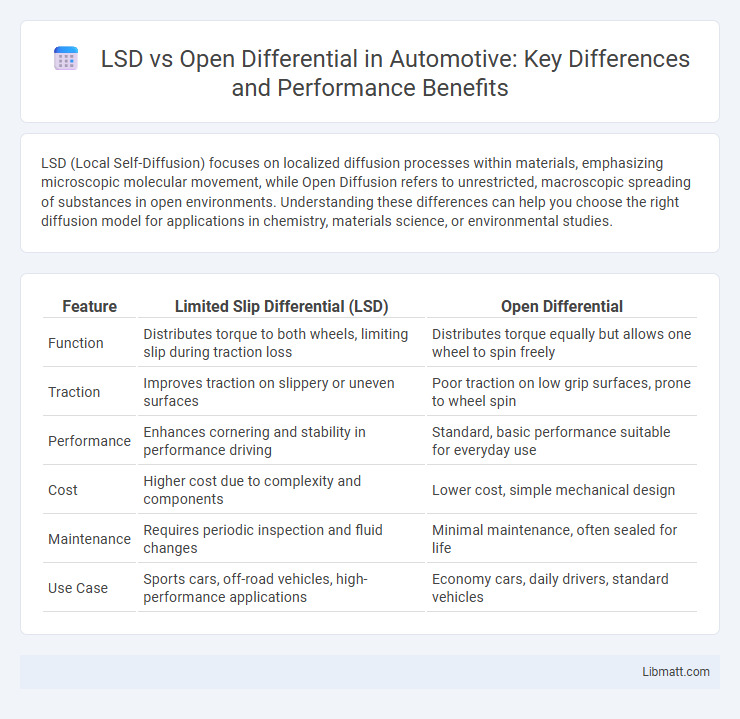LSD (Local Self-Diffusion) focuses on localized diffusion processes within materials, emphasizing microscopic molecular movement, while Open Diffusion refers to unrestricted, macroscopic spreading of substances in open environments. Understanding these differences can help you choose the right diffusion model for applications in chemistry, materials science, or environmental studies.
Table of Comparison
| Feature | Limited Slip Differential (LSD) | Open Differential |
|---|---|---|
| Function | Distributes torque to both wheels, limiting slip during traction loss | Distributes torque equally but allows one wheel to spin freely |
| Traction | Improves traction on slippery or uneven surfaces | Poor traction on low grip surfaces, prone to wheel spin |
| Performance | Enhances cornering and stability in performance driving | Standard, basic performance suitable for everyday use |
| Cost | Higher cost due to complexity and components | Lower cost, simple mechanical design |
| Maintenance | Requires periodic inspection and fluid changes | Minimal maintenance, often sealed for life |
| Use Case | Sports cars, off-road vehicles, high-performance applications | Economy cars, daily drivers, standard vehicles |
Introduction to LSD and Open Differential
LSD (Limited Slip Differential) and open differential are key components in vehicle drivetrain systems that manage how power is distributed to the wheels. LSD enhances traction by limiting wheel slip during acceleration or cornering, ensuring improved control and stability, especially on slippery surfaces. Your choice between LSD and an open differential directly affects handling dynamics and performance based on driving conditions.
How LSD Differentiates from Open Differential
LSD (Limited Slip Differential) enhances traction by distributing torque to the wheel with more grip, unlike an open differential that splits torque evenly between wheels regardless of traction. Open differentials allow wheels to spin independently, which can lead to loss of power on slippery surfaces, whereas LSD minimizes wheel slip to improve handling and stability during acceleration and cornering. Automotive enthusiasts and performance vehicles often prefer LSD for superior control and performance in varying driving conditions.
Mechanism of LSD vs Open Diff
LSD (Least Significant Difference) relies on pairwise comparisons using the Student's t-distribution to determine significant differences between group means, controlling for Type I error rate in multiple testing. Open Diff utilizes a more flexible algorithm based on Bayesian inference principles, incorporating prior distributions to refine difference estimates and account for uncertainty in the data. The LSD method is straightforward with fixed error rates, while Open Diff adapts dynamically to data variability, yielding more nuanced insights into group differences.
Performance Impact: LSD vs Open Differential
LSD (Limited Slip Differential) enhances traction by distributing torque more effectively between wheels during cornering or slippery conditions, reducing wheel spin and improving handling performance. In contrast, an open differential allows wheels to rotate at different speeds but can lead to reduced traction as torque is sent to the wheel with least resistance, causing potential power loss and decreased stability. Vehicles equipped with LSD demonstrate superior acceleration and control, particularly in high-performance or off-road scenarios, where maintaining grip is crucial for optimal performance.
Traction Control Comparison
LSD (Limited Slip Differential) offers superior traction control by distributing torque between wheels on the same axle to prevent wheel spin, especially during cornering or slippery conditions. Open differentials provide basic torque distribution but allow the wheel with less traction to spin freely, resulting in reduced grip and performance. Vehicles equipped with LSD demonstrate improved stability and acceleration on uneven surfaces compared to those with open diff systems.
Handling in Various Driving Conditions
LSD (Limited Slip Differential) enhances traction by distributing torque between wheels, improving stability and control on slippery or uneven surfaces. Open differentials allow wheels to rotate at different speeds but can lose traction when one wheel slips, making them less effective in challenging driving conditions like snow or off-road. Your vehicle's performance in diverse terrains is significantly improved with LSD, providing better handling and safety.
Longevity and Maintenance Considerations
LSD (Log-Structured Database) offers longevity through its append-only design, minimizing write amplification and prolonging storage medium lifespan compared to traditional databases. Open Diff solutions, often built on more conventional storage methods, may require frequent maintenance due to higher fragmentation and write amplification issues. Choosing LSD can reduce long-term maintenance costs and improve data durability in high-write environments.
Cost Analysis: LSD vs Open Diff
LSD (Limited Slip Differential) generally incurs higher costs compared to an open differential due to its complex internal mechanisms and enhanced traction capabilities. Maintenance expenses for LSD are also typically greater because of specialized components requiring periodic attention, whereas open differentials have simpler designs with lower upkeep requirements. When evaluating cost-effectiveness, open differentials offer budget-friendly initial investments and reduced maintenance outlays, while LSDs justify their premium price through improved performance and handling benefits.
Applications: Street, Track, and Off-Road
LSD (Limited Slip Differential) enhances traction by distributing torque evenly between wheels, making it ideal for street performance and track racing where controlled cornering and stability are crucial. Open differentials allow wheels to spin independently, providing smooth handling on paved roads but can struggle with traction in off-road conditions where one wheel might lose grip. Your choice depends on the application: LSD excels on the street and track for improved control, while open diffs perform adequately in everyday driving but are less suited for demanding off-road terrain.
Choosing Between LSD and Open Differential
Choosing between LSD (Limited Slip Differential) and an open differential depends on your vehicle's driving conditions and performance needs. LSD provides enhanced traction by distributing power to the wheel with more grip, ideal for high-performance driving or off-road scenarios. Your choice should reflect the balance between everyday usability with an open differential and improved handling and control offered by an LSD.
LSD vs open diff Infographic

 libmatt.com
libmatt.com